Activity-dependent synaptic plasticity in the supraoptic nucleus of the rat hypothalamus
- PMID: 16613872
- PMCID: PMC1779752
- DOI: 10.1113/jphysiol.2006.109447
Activity-dependent synaptic plasticity in the supraoptic nucleus of the rat hypothalamus
Abstract
Activity-dependent long-term synaptic changes were investigated at glutamatergic synapses in the supraoptic nucleus (SON) of the rat hypothalamus. In acute hypothalamic slices, high frequency stimulation (HFS) of afferent fibres caused long-term potentiation (LTP) of the amplitude of AMPA receptor-mediated excitatory postsynaptic currents (EPSCs) recorded with the whole-cell patch-clamp technique. LTP was also obtained in response to membrane depolarization paired with mild afferent stimulation. On the other hand, stimulating the inputs at 5 Hz for 3 min at resting membrane potential caused long-term depression (LTD) of excitatory transmission in the SON. These forms of synaptic plasticity required the activation of NMDA receptors since they were abolished in the presence of D-AP5 or ifenprodil, two selective blockers of these receptors. Analysis of paired-pulse facilitation and trial-to-trial variability indicated that LTP and LTD were not associated with changes in the probability of transmitter release, thereby suggesting that the locus of expression of these phenomena was postsynaptic. Using sharp microelectrode recordings in a hypothalamic explant preparation, we found that HFS also generates LTP at functionally defined glutamatergic synapses formed between the organum vasculosum lamina terminalis and SON neurons. Taken together, our findings indicate that glutamatergic synapses in the SON exhibit activity-dependent long-term synaptic changes similar to those prevailing in other brain areas. Such forms of plasticity could play an important role in the context of physiological responses, like dehydration or lactation, where the activity of presynaptic glutamatergic neurons is strongly increased.
Figures
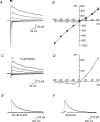

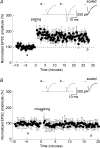
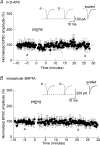


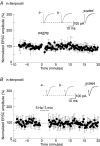

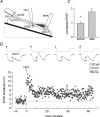
Similar articles
-
Potentiation of glutamatergic synaptic input to supraoptic neurons by presynaptic nicotinic receptors.Am J Physiol Regul Integr Comp Physiol. 2001 Oct;281(4):R1105-13. doi: 10.1152/ajpregu.2001.281.4.R1105. Am J Physiol Regul Integr Comp Physiol. 2001. PMID: 11557616
-
Short-term potentiation of miniature excitatory synaptic currents causes excitation of supraoptic neurons.J Neurophysiol. 2000 May;83(5):2542-53. doi: 10.1152/jn.2000.83.5.2542. J Neurophysiol. 2000. PMID: 10805656
-
Physiological evidence for local excitatory synaptic circuits in the rat hypothalamus.J Neurophysiol. 1997 Jun;77(6):3396-400. doi: 10.1152/jn.1997.77.6.3396. J Neurophysiol. 1997. PMID: 9212285
-
Expression mechanisms underlying long-term potentiation: a postsynaptic view, 10 years on.Philos Trans R Soc Lond B Biol Sci. 2013 Dec 2;369(1633):20130136. doi: 10.1098/rstb.2013.0136. Print 2014 Jan 5. Philos Trans R Soc Lond B Biol Sci. 2013. PMID: 24298139 Free PMC article. Review.
-
Glial modulation of synaptic transmission: Insights from the supraoptic nucleus of the hypothalamus.Glia. 2004 Aug 15;47(3):258-267. doi: 10.1002/glia.20032. Glia. 2004. PMID: 15252815 Review.
Cited by
-
Brain-derived neurotrophic factor-tyrosine kinase B pathway mediates NMDA receptor NR2B subunit phosphorylation in the supraoptic nuclei following progressive dehydration.J Neuroendocrinol. 2011 Oct;23(10):894-905. doi: 10.1111/j.1365-2826.2011.02209.x. J Neuroendocrinol. 2011. PMID: 21848649 Free PMC article.
-
Bidirectional neuro-glial signaling modalities in the hypothalamus: role in neurohumoral regulation.Auton Neurosci. 2013 Apr;175(1-2):51-60. doi: 10.1016/j.autneu.2012.12.009. Epub 2013 Jan 30. Auton Neurosci. 2013. PMID: 23375650 Free PMC article. Review.
-
Calcium Dynamics in Hypothalamic Paraventricular Oxytocin Neurons and Astrocytes Associated with Social and Stress Stimuli.eNeuro. 2025 May 12;12(5):ENEURO.0196-24.2025. doi: 10.1523/ENEURO.0196-24.2025. Print 2025 May. eNeuro. 2025. PMID: 40262904 Free PMC article.
-
Central clock excites vasopressin neurons by waking osmosensory afferents during late sleep.Nat Neurosci. 2010 Apr;13(4):467-74. doi: 10.1038/nn.2503. Epub 2010 Feb 28. Nat Neurosci. 2010. PMID: 20190744
-
High dietary salt amplifies osmoresponsiveness in vasopressin-releasing neurons.Cell Rep. 2021 Mar 16;34(11):108866. doi: 10.1016/j.celrep.2021.108866. Cell Rep. 2021. PMID: 33730577 Free PMC article.
References
-
- Csaki A, Kocsis K, Kiss J, Halasz B. Localization of putative glutamatergic/aspartatergic neurons projecting to the supraoptic nucleus area of the rat hypothalamus. Eur J Neurosci. 2002;16:55–68. - PubMed
-
- Cummings JA, Mulkey RM, Nicoll RA, Malenka RC. Ca2+ signaling requirements for long-term depression in the hippocampus. Neuron. 1996;16:825–833. - PubMed
-
- Gentles SJ. Montreal, Canada: McGill University; 1987. Patterned afferent activity and synaptic plasticity in the magnocellular neurosecretory system. MSc Thesis.
Publication types
MeSH terms
Substances
LinkOut - more resources
Full Text Sources

